tire pressure SUBARU OUTBACK 2007 4.G Owner's Guide
[x] Cancel search | Manufacturer: SUBARU, Model Year: 2007, Model line: OUTBACK, Model: SUBARU OUTBACK 2007 4.GPages: 442, PDF Size: 13.39 MB
Page 416 of 442
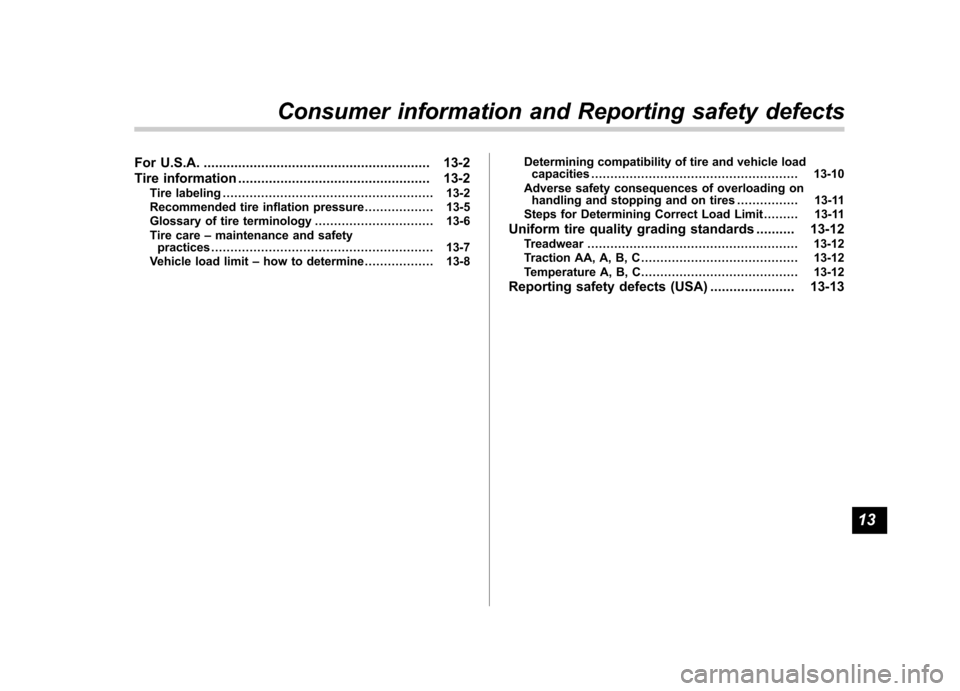
For U.S.A............................................................ 13-2
Tire information .................................................. 13-2
Tire labeling ....................................................... 13-2
Recommended tire inflation pressure .................. 13-5
Glossary of tire terminology ............................... 13-6
Tire care –maintenance and safety
practices .......................................................... 13-7
Vehicle load limit –how to determine .................. 13-8 Determining compatibility of tire and vehicle load
capacities ...................................................... 13-10
Adverse safety consequences of overloading on handling and stopping and on tires ................ 13-11
Steps for Determining Correct Load Limit ......... 13-11
Uniform tire quality grading standards .......... 13-12
Treadwear ....................................................... 13-12
Traction AA, A, B, C ......................................... 13-12
Temperature A, B, C ......................................... 13-12
Reporting safety defects (USA) ...................... 13-13
Consumer information and Reporting safety defects
13
Page 418 of 442
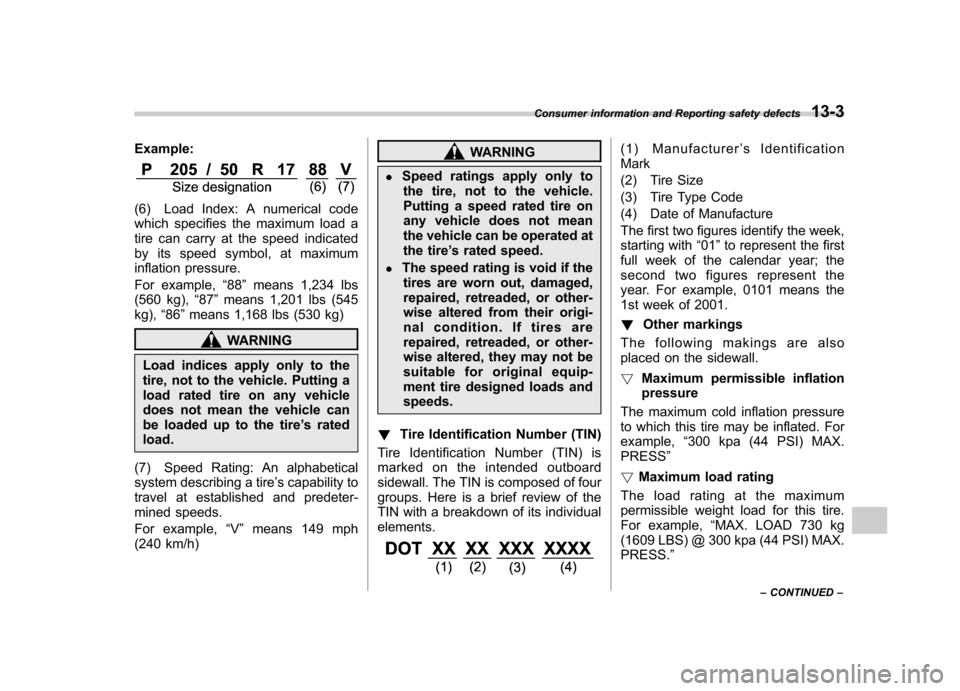
Example:
(6) Load Index: A numerical code
which specifies the maximum load a
tire can carry at the speed indicated
by its speed symbol, at maximum
inflation pressure.
For example,“88 ”means 1,234 lbs
(560 kg), “87 ”means 1,201 lbs (545
kg), “86 ”means 1,168 lbs (530 kg)
WARNING
Load indices apply only to the
tire, not to the vehicle. Putting a
load rated tire on any vehicle
does not mean the vehicle can
be loaded up to the tire ’s rated
load.
(7) Speed Rating: An alphabetical
system describing a tire ’s capability to
travel at established and predeter-
mined speeds.
For example, “V ” means 149 mph
(240 km/h)
WARNING
. Speed ratings apply only to
the tire, not to the vehicle.
Putting a speed rated tire on
any vehicle does not mean
the vehicle can be operated at
the tire ’s rated speed.
. The speed rating is void if the
tires are worn out, damaged,
repaired, retreaded, or other-
wise altered from their origi-
nal condition. If tires are
repaired, retreaded, or other-
wise altered, they may not be
suitable for original equip-
ment tire designed loads and speeds.
! Tire Identification Number (TIN)
Tire Identification Number (TIN) is
marked on the intended outboard
sidewall. The TIN is composed of four
groups. Here is a brief review of the
TIN with a breakdown of its individual
elements.(1) Manufacturer ’s Identification
Mark
(2) Tire Size
(3) Tire Type Code
(4) Date of Manufacture
The first two figures identify the week,
starting with “01 ”to represent the first
full week of the calendar year; the
second two figures represent the
year. For example, 0101 means the
1st week of 2001. ! Other markings
The following makings are also
placed on the sidewall. ! Maximum permissible inflation
pressure
The maximum cold inflation pressure
to which this tire may be inflated. For
example, “300 kpa (44 PSI) MAX.
PRESS ”
! Maximum load rating
Theloadratingatthemaximum
permissible weight load for this tire.
For example, “MAX. LOAD 730 kg
(1609 LBS) @ 300 kpa (44 PSI) MAX.
PRESS. ”
Consumer information and Reporting safety defects
13-3
– CONTINUED –
Page 420 of 442
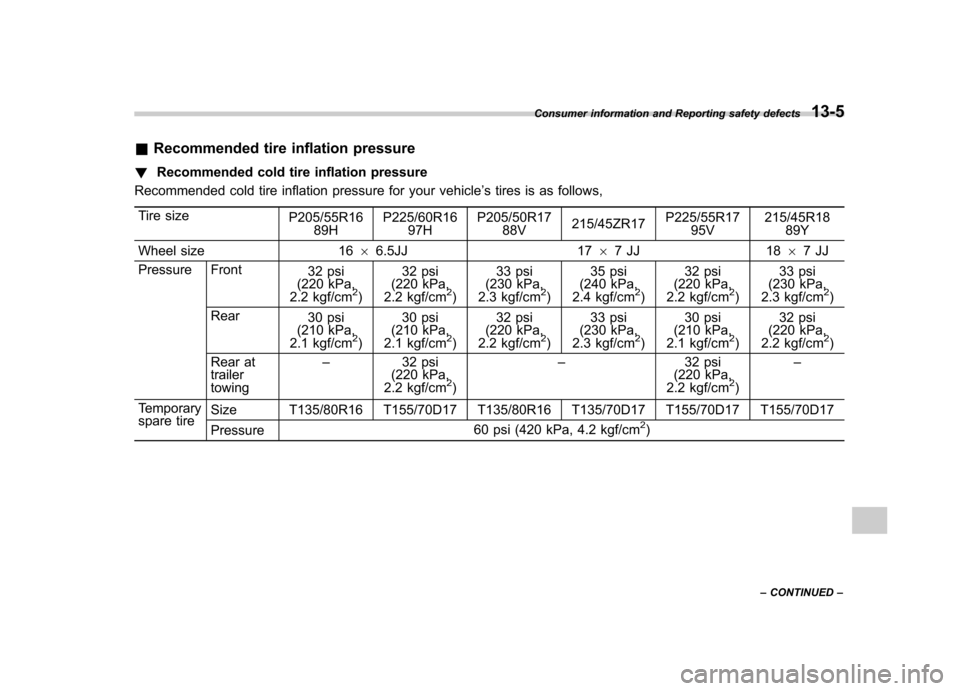
&Recommended tire inflation pressure
! Recommended cold tire inflation pressure
Recommended cold tire inflation pressure for your vehicle ’s tires is as follows,
Tire size P205/55R16
89H P225/60R16
97H P205/50R17
88V 215/45ZR17 P225/55R17
95V 215/45R18
89Y
Wheel size 16 66.5JJ 17 67JJ 18 67JJ
Pressure Front 32 psi
(220 kPa,
2.2 kgf/cm
2) 32 psi
(220 kPa,
2.2 kgf/cm2) 33 psi
(230 kPa,
2.3 kgf/cm2) 35 psi
(240 kPa,
2.4 kgf/cm2) 32 psi
(220 kPa,
2.2 kgf/cm2) 33 psi
(230 kPa,
2.3 kgf/cm2)
Rear 30 psi
(210 kPa,
2.1 kgf/cm
2) 30 psi
(210 kPa,
2.1 kgf/cm2) 32 psi
(220 kPa,
2.2 kgf/cm2) 33 psi
(230 kPa,
2.3 kgf/cm2) 30 psi
(210 kPa,
2.1 kgf/cm2) 32 psi
(220 kPa,
2.2 kgf/cm2)
Rear at trailertowing –
32 psi
(220 kPa,
2.2 kgf/cm
2) –
32 psi
(220 kPa,
2.2 kgf/cm2) –
Temporary
spare tire Size T135/80R16 T155/70D17 T135/80R16 T135/70D17 T155/70D17 T155/70D17
Pressure
60 psi (420 kPa, 4.2 kgf/cm
2)
Consumer information and Reporting safety defects
13-5
– CONTINUED –
Page 421 of 442
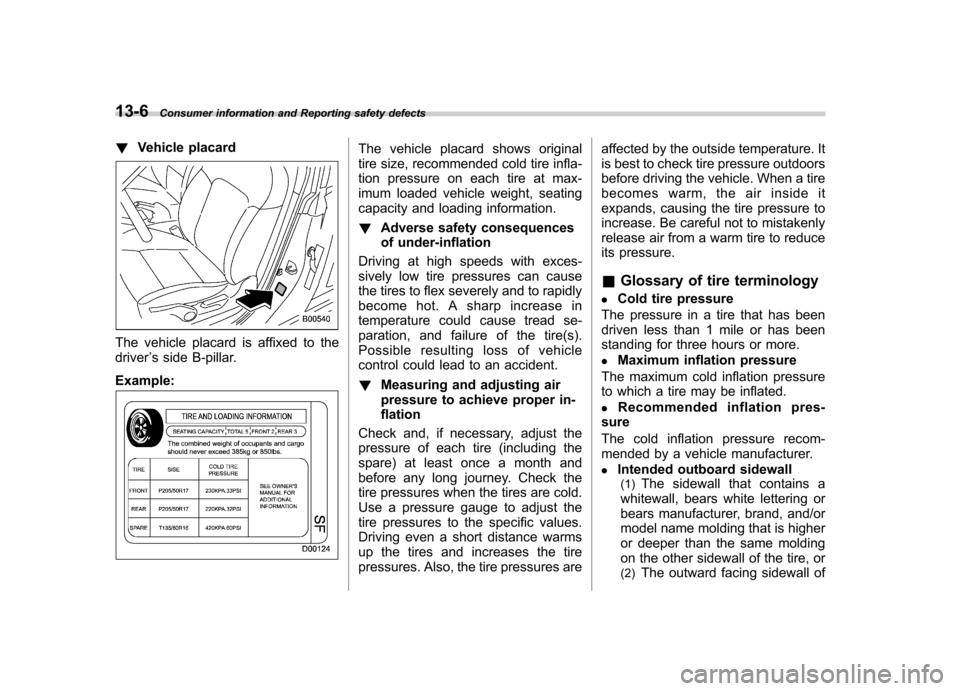
13-6Consumer information and Reporting safety defects
! Vehicle placard
The vehicle placard is affixed to the driver ’s side B-pillar.
Example:
The vehicle placard shows original
tire size, recommended cold tire infla-
tion pressure on each tire at max-
imum loaded vehicle weight, seating
capacity and loading information. ! Adverse safety consequences
of under-inflation
Driving at high speeds with exces-
sively low tire pressures can cause
the tires to flex severely and to rapidly
become hot. A sharp increase in
temperature could cause tread se-
paration, and failure of the tire(s).
Possible resulting loss of vehicle
control could lead to an accident. ! Measuring and adjusting air
pressure to achieve proper in-
flation
Check and, if necessary, adjust the
pressure of each tire (including the
spare) at least once a month and
before any long journey. Check the
tire pressures when the tires are cold.
Use a pressure gauge to adjust the
tire pressures to the specific values.
Driving even a short distance warms
up the tires and increases the tire
pressures. Also, the tire pressures are affected by the outside temperature. It
is best to check tire pressure outdoors
before driving the vehicle. When a tire
becomes warm, the air inside it
expands, causing the tire pressure to
increase. Be careful not to mistakenly
release air from a warm tire to reduce
its pressure. &
Glossary of tire terminology
. Cold tire pressure
The pressure in a tire that has been
driven less than 1 mile or has been
standing for three hours or more. . Maximum inflation pressure
The maximum cold inflation pressure
to which a tire may be inflated. . Recommended inflation pres-
sure
The cold inflation pressure recom-
mended by a vehicle manufacturer. . Intended outboard sidewall
(1) The sidewall that contains a
whitewall, bears white lettering or
bears manufacturer, brand, and/or
model name molding that is higher
or deeper than the same molding
on the other sidewall of the tire, or (2) The outward facing sidewall of
Page 422 of 442
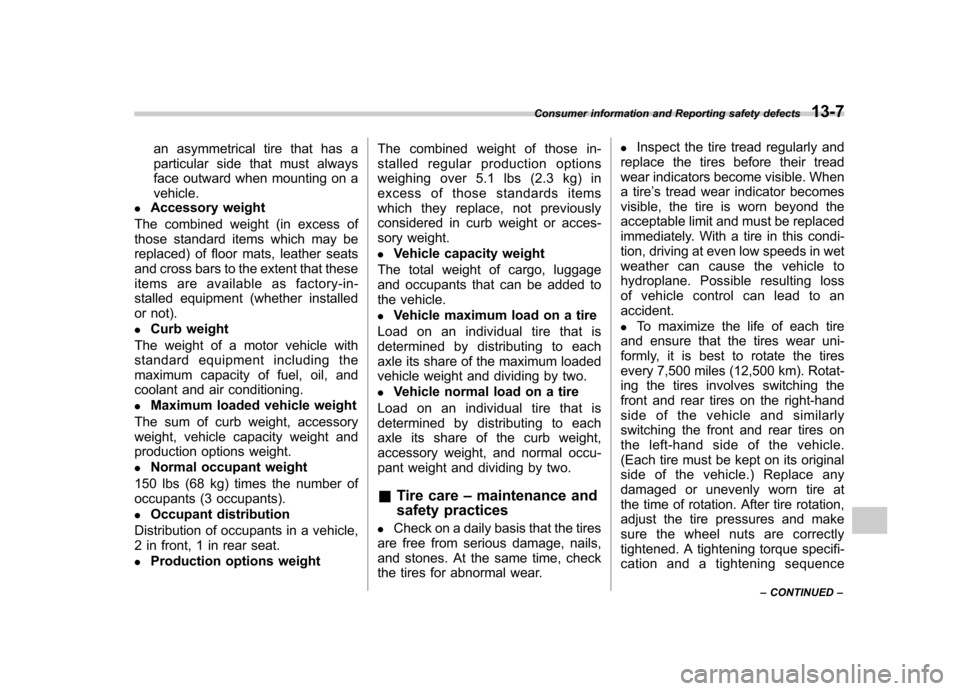
an asymmetrical tire that has a
particular side that must always
face outward when mounting on a
vehicle.
. Accessory weight
The combined weight (in excess of
those standard items which may be
replaced) of floor mats, leather seats
and cross bars to the extent that these
items are available as factory-in-
stalled equipment (whether installed
or not). . Curb weight
The weight of a motor vehicle with
standard equipment including the
maximum capacity of fuel, oil, and
coolant and air conditioning. . Maximum loaded vehicle weight
The sum of curb weight, accessory
weight, vehicle capacity weight and
production options weight. . Normal occupant weight
150 lbs (68 kg) times the number of
occupants (3 occupants). . Occupant distribution
Distribution of occupants in a vehicle,
2 in front, 1 in rear seat. . Production options weight The combined weight of those in-
stalled regular production options
weighing over 5.1 lbs (2.3 kg) in
excess of those standards items
which they replace, not previously
considered in curb weight or acces-
sory weight. .
Vehicle capacity weight
The total weight of cargo, luggage
and occupants that can be added to
the vehicle. . Vehicle maximum load on a tire
Load on an individual tire that is
determined by distributing to each
axle its share of the maximum loaded
vehicle weight and dividing by two. . Vehicle normal load on a tire
Load on an individual tire that is
determined by distributing to each
axle its share of the curb weight,
accessory weight, and normal occu-
pant weight and dividing by two. & Tire care –maintenance and
safety practices
. Check on a daily basis that the tires
are free from serious damage, nails,
and stones. At the same time, check
the tires for abnormal wear. .
Inspect the tire tread regularly and
replace the tires before their tread
wear indicators become visible. When
a tire ’s tread wear indicator becomes
visible, the tire is worn beyond the
acceptable limit and must be replaced
immediately. With a tire in this condi-
tion, driving at even low speeds in wet
weather can cause the vehicle to
hydroplane. Possible resulting loss
of vehicle control can lead to an
accident. . To maximize the life of each tire
and ensure that the tires wear uni-
formly, it is best to rotate the tires
every 7,500 miles (12,500 km). Rotat-
ing the tires involves switching the
front and rear tires on the right-hand
side of the vehicle and similarly
switching the front and rear tires on
the left-hand side of the vehicle.
(Each tire must be kept on its original
side of the vehicle.) Replace any
damaged or unevenly worn tire at
the time of rotation. After tire rotation,
adjust the tire pressures and make
sure the wheel nuts are correctly
tightened. A tightening torque specifi-
cation and a tightening sequence
Consumer information and Reporting safety defects
13-7
– CONTINUED –
Page 437 of 442
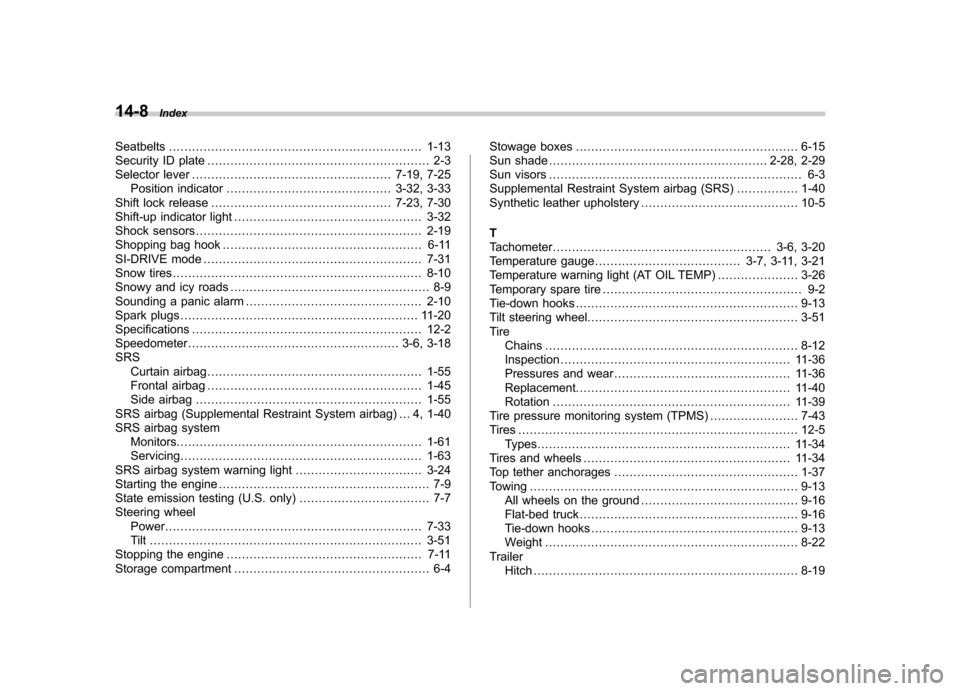
14-8Index
Seatbelts .................................................................. 1-13
Security ID plate .......................................................... 2-3
Selector lever .................................................... 7-19, 7-25
Position indicator ........................................... 3-32, 3-33
Shift lock release ............................................... 7-23, 7-30
Shift-up indicator light ................................................. 3-32
Shock sensors ........................................................... 2-19
Shopping bag hook .................................................... 6-11
SI-DRIVE mode ......................................................... 7-31
Snow tires ................................................................. 8-10
Snowy and icy roads .................................................... 8-9
Sounding a panic alarm .............................................. 2-10
Spark plugs .............................................................. 11-20
Specifications ............................................................ 12-2
Speedometer ....................................................... 3-6, 3-18
SRS
Curtain airbag ........................................................ 1-55
Frontal airbag ........................................................ 1-45
Side airbag ........................................................... 1-55
SRS airbag (Supplemental Restraint System airbag) ... 4, 1-40
SRS airbag system
Monitors. ............................................................... 1-61
Servicing ............................................................... 1-63
SRS airbag system warning light ................................. 3-24
Starting the engine ....................................................... 7-9
State emission testing (U.S. only) .................................. 7-7
Steering wheel
Power ................................................................... 7-33
Tilt ....................................................................... 3-51
Stopping the engine ................................................... 7-11
Storage compartment ................................................... 6-4 Stowage boxes
.......................................................... 6-15
Sun shade ......................................................... 2-28, 2-29
Sun visors .................................................................. 6-3
Supplemental Restraint System airbag (SRS) ................ 1-40
Synthetic leather upholstery ......................................... 10-5
T
Tachometer ......................................................... 3-6, 3-20
Temperature gauge ...................................... 3-7, 3-11, 3-21
Temperature warning light (AT OIL TEMP) ..................... 3-26
Temporary spare tire .................................................... 9-2
Tie-down hooks .......................................................... 9-13
Tilt steering wheel. ...................................................... 3-51
Tire
Chains .................................................................. 8-12
Inspection ............................................................ 11-36
Pressures and wear .............................................. 11-36
Replacement. ....................................................... 11-40
Rotation .............................................................. 11-39
Tire pressure monitoring system (TPMS) ....................... 7-43
Tires ......................................................................... 12-5
Types .................................................................. 11-34
Tires and wheels ...................................................... 11-34
Top tether anchorages ................................................ 1-37
Towing ...................................................................... 9-13
All wheels on the ground ......................................... 9-16
Flat-bed truck ......................................................... 9-16
Tie-down hooks ...................................................... 9-13
Weight .................................................................. 8-22
Trailer
Hitch ..................................................................... 8-19
Page 442 of 442

&Cold tire pressure:
Tire size P205/55R16 89H P225/60R16 97H P205/50R17 88V 215/45ZR17 P225/55R17 95V 215/45R18 89Y
Wheel size 16 66.5JJ 1767JJ 18 67JJ
Pressure Front 32 psi (220 kPa,
2.2 kgf/cm
2) 32 psi (220 kPa,
2.2 kgf/cm2) 33 psi (230 kPa,
2.3 kgf/cm2) 35 psi (240 kPa,
2.4 kgf/cm2) 32 psi (220 kPa,
2.2 kgf/cm2) 33 psi (230 kPa,
2.3 kgf/cm2)
Rear 30 psi (210 kPa,
2.1 kgf/cm
2) 30 psi (210 kPa,
2.1 kgf/cm2) 32 psi (220 kPa,
2.2 kgf/cm2) 33 psi (230 kPa,
2.3 kgf/cm2) 30 psi (210 kPa,
2.1 kgf/cm2) 32 psi (220 kPa,
2.2 kgf/cm2)
Rear at trailer towing –
32 psi (220 kPa,
2.2 kgf/cm
2) –
32 psi (220 kPa,
2.2 kgf/cm2) –
Temporary
spare tire Size T135/80R16 T155/70D17 T135/80R16 T135/70D17 T155/70D17 T155/70D17 Pressure
60 psi (420 kPa, 4.2 kgf/cm
2)